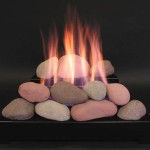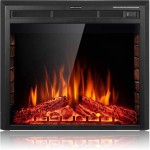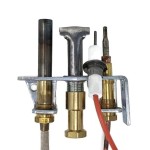Cleaning Gas Fireplace Logs: A Comprehensive Guide
Gas fireplaces offer a convenient and aesthetically pleasing alternative to traditional wood-burning fireplaces. They provide instant heat and require less maintenance in terms of fuel sourcing. However, even gas fireplaces require regular cleaning to maintain optimal performance and appearance. The logs, in particular, accumulate soot and dust over time, diminishing their realistic charm and potentially affecting the efficiency of the fireplace. This article provides a detailed guide to cleaning gas fireplace logs safely and effectively.
Understanding the Importance of Cleaning
Regular cleaning of gas fireplace logs is not merely an aesthetic concern; it directly impacts the performance and longevity of the appliance. A buildup of soot and dust can obstruct the gas ports, leading to incomplete combustion and a less efficient flame. This can result in reduced heat output and increased gas consumption. Moreover, the accumulated debris can potentially react with the materials of the logs, causing degradation and shortening their lifespan.
Furthermore, proper cleaning helps maintain the realistic appearance of the logs. Over time, soot can obscure the details and textures that make the logs resemble genuine wood. Restoring the logs to their original condition enhances the overall ambiance of the fireplace and the room it occupies. Neglecting to clean the logs can also lead to unpleasant odors, especially when the fireplace is first ignited.
Safety is another crucial consideration. While gas fireplaces are generally safe, a malfunction caused by debris buildup can potentially lead to carbon monoxide leaks. Although modern gas fireplaces are equipped with safety shut-off mechanisms, regular maintenance, including log cleaning, is essential for preventing hazardous situations.
Preparing for the Cleaning Process
Before commencing the cleaning process, it is vital to gather the necessary materials and take appropriate safety precautions. This preparation ensures a smooth and efficient cleaning process while minimizing the risk of damage or injury.
Firstly, ensure the gas supply to the fireplace is completely shut off. Locate the gas valve, typically situated near the fireplace or in an adjacent utility room, and turn it to the "off" position. Allow the fireplace to cool down completely before proceeding. Attempting to clean the logs while they are still hot can cause burns and damage the logs.
Next, assemble the following materials: a soft-bristled brush (preferably a brush specifically designed for cleaning fireplaces), a vacuum cleaner with a hose attachment, a drop cloth or old newspapers to protect the surrounding area, mild dish soap, warm water, soft cloths or sponges, and safety glasses and gloves. The soft-bristled brush is essential for removing loose soot and dust without scratching the delicate surface of the logs. The vacuum cleaner will help remove larger debris and prevent dust from spreading throughout the room. The drop cloth or newspapers will protect the floor and hearth from spills and grime. The mild dish soap and warm water will effectively clean the logs without damaging their finish. Safety glasses and gloves provide protection against dust and irritants.
Protect the surrounding area by spreading the drop cloth or old newspapers around the fireplace. This will catch any falling debris and prevent staining or damage to the floor or hearth. Open windows or ensure adequate ventilation to minimize the inhalation of dust particles.
Step-by-Step Cleaning Instructions
Once the preparations are complete, the actual cleaning process can begin. Follow these steps carefully to ensure the logs are thoroughly cleaned without compromising their integrity.
Step 1: Removing Loose Debris. Begin by using the soft-bristled brush to gently remove any loose soot, dust, or debris from the surface of the logs. Work systematically, brushing all sides of each log. Be careful not to apply too much pressure, as this can scratch or damage the logs. Focus on areas where soot accumulation is most apparent, such as crevices and textured surfaces. The goal is to remove as much loose debris as possible before proceeding to the next step.
Step 2: Vacuuming the Logs. After brushing, use the vacuum cleaner with the hose attachment to remove any remaining loose debris. Carefully vacuum each log, paying attention to crevices and hard-to-reach areas. The vacuum cleaner will help remove any dust that the brush may have missed. This step is crucial for preventing dust from spreading throughout the room during the cleaning process.
Step 3: Washing the Logs. In a bucket or container, mix a small amount of mild dish soap with warm water. Dip a soft cloth or sponge into the soapy water and gently wipe down each log. Avoid using abrasive cleaners or scouring pads, as these can damage the finish of the logs. Focus on areas where soot or grime is particularly stubborn. Wring out the cloth or sponge frequently to prevent excessive dripping. The soapy water will help loosen any remaining dirt and grime, leaving the logs clean and refreshed.
Step 4: Rinsing the Logs. After washing the logs, use a clean, damp cloth or sponge to rinse them with plain warm water. This will remove any soap residue that may have been left behind. Ensure that all soap residue is removed, as it can attract dust and dirt in the future. Wring out the cloth or sponge frequently to prevent excessive dripping. Rinsing the logs thoroughly is essential for maintaining their appearance and preventing any potential discoloration.
Step 5: Drying the Logs. Once the logs have been rinsed, allow them to air dry completely before reassembling them in the fireplace. This may take several hours, depending on the humidity and temperature of the room. Alternatively, you can use a clean, dry cloth to gently dry the logs. Ensure that the logs are completely dry before reassembling them, as moisture can promote the growth of mold or mildew. Placing the logs in a well-ventilated area will expedite the drying process.
Step 6: Cleaning the Fireplace Interior. While the logs are drying, take the opportunity to clean the interior of the fireplace. Use the vacuum cleaner with the hose attachment to remove any dust, debris, or soot from the firebox floor and walls. Wipe down the interior surfaces with a damp cloth to remove any remaining grime. Pay particular attention to the gas ports, ensuring that they are free from obstructions. A clean fireplace interior not only enhances the appearance of the fireplace but also promotes efficient combustion and reduces the risk of carbon monoxide buildup.
Step 7: Reassembling the Logs. Once the logs are completely dry and the fireplace interior has been cleaned, carefully reassemble the logs in their original positions. Refer to the manufacturer's instructions or take a photograph of the log arrangement before disassembling them to ensure proper placement. Proper log placement is crucial for achieving an aesthetically pleasing appearance and ensuring efficient gas flow. Make sure that the logs are securely positioned and do not obstruct the gas ports.
Troubleshooting Common Issues
Even with careful cleaning, certain issues may arise during or after the cleaning process. Addressing these issues promptly ensures the continued performance and appearance of the gas fireplace.
Stubborn Soot Stains: If soot stains persist despite washing, try using a specialized fireplace cleaner designed for gas logs. These cleaners typically contain stronger detergents that can effectively remove stubborn stains. Always follow the manufacturer's instructions and test the cleaner on an inconspicuous area of the log before applying it to the entire surface. Avoid using harsh chemicals or abrasive cleaners, as these can damage the logs.
Damaged or Cracked Logs: If any of the logs are damaged or cracked, consider replacing them. Damaged logs can compromise the efficiency and safety of the fireplace. Contact the fireplace manufacturer or a qualified technician to obtain replacement logs that are compatible with your fireplace model. Replacing damaged logs is essential for maintaining the proper functionality and appearance of the fireplace.
Gas Odor After Cleaning: If you detect a gas odor after cleaning the fireplace, immediately shut off the gas supply and ventilate the room. Check for any leaks in the gas line or connections. Contact a qualified technician to inspect the fireplace and repair any leaks before using it again. Gas leaks are a serious safety hazard and should be addressed immediately.
Pilot Light Issues: If the pilot light fails to ignite after cleaning the fireplace, check the gas supply and ensure that the gas valve is turned on. Clean the pilot light assembly with a small brush or needle to remove any debris that may be obstructing the gas flow. If the pilot light still fails to ignite, consult the fireplace manufacturer's instructions or contact a qualified technician for assistance. A malfunctioning pilot light can prevent the fireplace from operating properly.
Incorrect Log Placement: If the flame appears uneven or weak after reassembling the logs, double-check the log placement. Refer to the manufacturer's instructions or the photograph you took before disassembling the logs to ensure that they are positioned correctly. Incorrect log placement can obstruct the gas ports and affect the flame pattern.
Preventative Maintenance Tips
In addition to regular cleaning, implementing preventative maintenance practices can help prolong the life of gas fireplace logs and maintain their optimal performance.
Regular Inspections: Regularly inspect the logs for any signs of damage, such as cracks, chips, or discoloration. Address any issues promptly to prevent further deterioration. Early detection of damage allows for timely repairs or replacements, preventing more significant problems from developing.
Professional Servicing: Schedule professional servicing of the gas fireplace at least once a year. A qualified technician can inspect the entire system, including the gas lines, burner assembly, and ventilation system, to ensure that it is operating safely and efficiently. Professional servicing helps identify and address potential problems before they become major issues.
Proper Ventilation: Ensure that the fireplace is properly ventilated. Keep the air vents clear of obstructions to allow for proper airflow. Adequate ventilation is essential for efficient combustion and reduces the risk of carbon monoxide buildup.
Using the Correct Fuel: Only use the type of gas that is specified for your fireplace model. Using the wrong type of gas can damage the fireplace and create a safety hazard. Refer to the manufacturer's instructions to determine the appropriate fuel type.
Avoiding Overuse: Avoid overusing the fireplace. Excessive use can accelerate the buildup of soot and debris, requiring more frequent cleaning. Limiting the amount of time the fireplace is used can help prolong the life of the logs and reduce maintenance requirements.

How To Clean A Gas Log Fireplace Ina Comfort Air

Why Is It Important To Get My Gas Fireplace Logs Clean Regularly

How To Clean A Gas Fireplace The Proper Way

How To Gas Log Cleaning Blog Fireplace And Chimney Authority

How To Clean Soot From A Gas Log Set Vertical Chimney Care

How To Clean Gas Fireplace Logs Steps The Flame Company

How To Clean Soot From A Gas Log Set Vertical Chimney Care

How To Clean Soot From A Gas Log Set Full Service Chimney

How To Clean Gas Logs 10 Steps With S Fireplace Indoor

Gas Log Cleaners Houston Tx Lords Chimney








